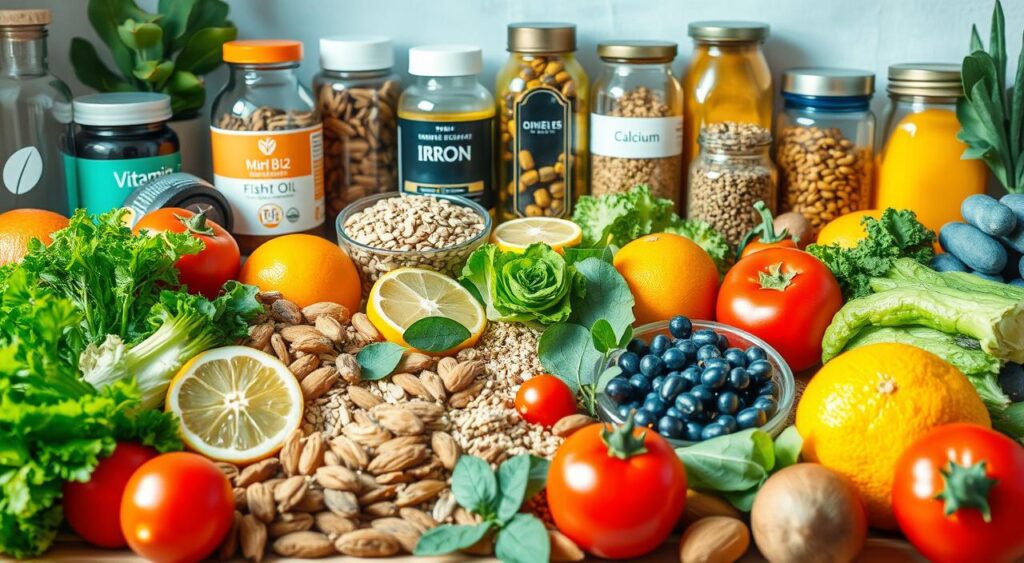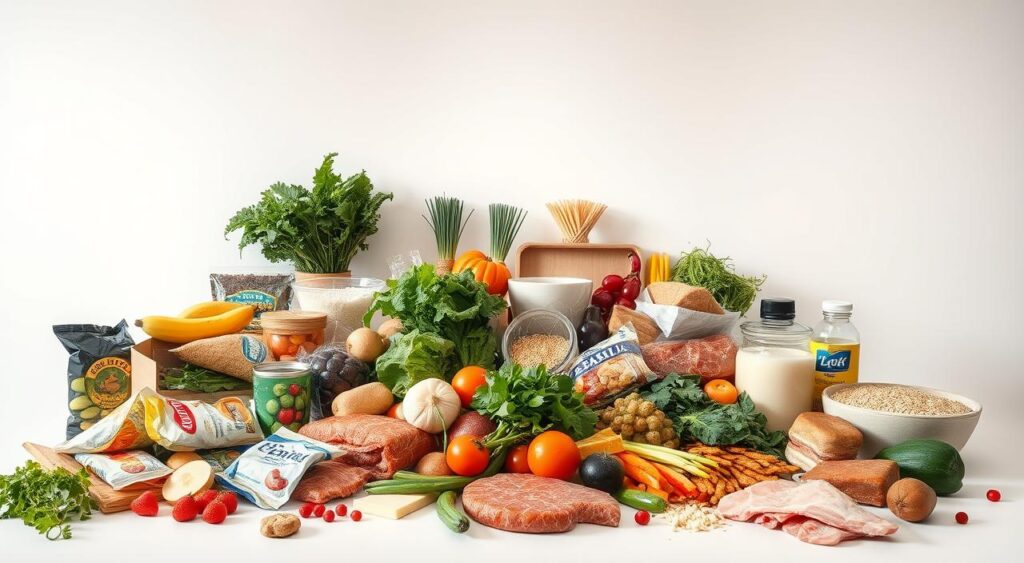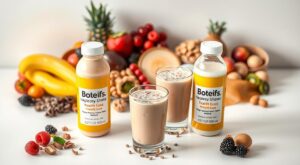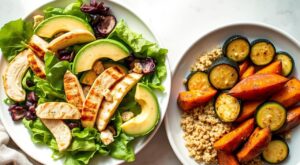Can a mostly plant-first plan really improve your health while still letting you enjoy meat and fish?
You’ll find out. This guide gives a science-backed snapshot of the flexible eating approach created by registered dietitian Dawn Jackson Blatner. It shows how shifting toward plants—with small amounts of animal foods—can help with weight control, heart markers, blood sugar, and even cancer risk.
Short summaries of major research and study results follow, plus practical tips on foods to favor and nutrients to watch, like B12 and iron. You’ll see everyday ways to build a plate that fits your routine without strict rules.
For a deeper primer on the eating pattern and supporting studies, check this flexitarian diet guide. Ready to learn which changes can move the needle on your health? Keep reading.
What the Flexitarian Diet Is and Why It’s So Popular Right Now
Think of this as a guide to eating more plants while keeping room for occasional meat, fish, eggs, and dairy.
In plain terms: the approach combines “flexible” and “vegetarian.” You focus on fruits, vegetables, legumes, and whole grains while using animal foods sparingly. There are no strict calorie or macro rules—just simple principles that make the plan easy to follow.
A flexible, mostly plant-based approach that still allows animal foods
The pattern encourages plant proteins first and lets you include meat, fish, dairy, or eggs in moderation. Some research defines semi-vegetarian patterns as eating non-fish meat about once a week or less.
How “flexible” differs from vegetarian and vegan approaches
Unlike a strict vegetarian diet or vegan plan, this style isn’t all-or-nothing. You get the plant-forward perks but can use animal options as targeted nutrient sources—B12, iron, or omega-3s—when you need them.
“Many people choose this approach for health, variety, cost savings, and simpler meal planning.”
- You can tailor it to your schedule and weight goals without constant tracking of body mass index.
- Surveys show rising interest as meals with less meat often cost less and feel more varied to people over time.
How the Flexitarian Diet Works in Real Life
You can make this approach work in everyday life by using a simple plate formula and smart shopping habits.
Core principles to follow
Eat mostly whole plants: fill your plate with fruits, vegetables, whole grains, and legumes. Limit ultra-processed foods and added sugar to steady your energy and improve intake quality.
Practical plate building
Start with plants, add a serving of protein, then layer in optional animal items like a small portion of meat, fish, or dairy.
- Fill most of the plate with vegetables, grains, beans, or lentils.
- Use beans, lentils, tofu, or tempeh as your default protein—swap these often for variety.
- Plan meat per week on a few set days so you stay consistent without strict rules.
- Batch-cook grains and roast vegetables to make plants the easy choice.
Mindful portions help you manage weight while staying satisfied. Simple planning keeps grocery trips fast and your week predictable.
Flexitarian Diet Benefits: The Science You Can Trust
Clear, repeatable findings show that leaning toward plants and cutting back on meat has measurable effects you can feel.
What current research says about semi-vegetarian patterns
Large analyses back this up. A 2020 review of 10,797 adults found lower BMI, total cholesterol, and blood pressure among people who reduced or excluded meat compared with regular meat eaters.
Other reviews report that vegetarian diets lower systolic and diastolic blood pressure and improve lipid profiles. Cohort studies also link fish-eating and vegetarian patterns with lower ischemic heart disease.
Why study results from vegetarian and pescatarian diets still matter to you
Your plate overlaps heavily with those patterns, so their findings translate well. Plant-forward choices—especially whole grains, vegetables, nuts, and legumes—are tied to lower type 2 diabetes risk and better weight control over time.
- You’ll see consistent reductions in blood pressure and cholesterol across large populations.
- Semi-vegetarians often show intermediate but meaningful wins for weight and metabolic markers.
- Quality matters: whole plant foods beat refined, sugary options for lowering disease risk.
Practical takeaway: small swaps—beans for half the meat in a recipe, extra veggies with grains—deliver study-backed improvements without major upheaval to your meals.
Heart Health Advantages: Cholesterol, Blood Pressure, and Reduced Risk
You can lower your long-term risk for heart disease with steady shifts in what you eat. Small swaps—more beans and vegetables, less processed meat—change the mix of fiber, antioxidants, and healthy fats on your plate.
What the evidence shows: in cohorts of over 48,000 participants, fish eaters and vegetarians had about 13% and 22% lower ischemic heart disease rates than regular meat eaters. A 2020 review of 15 studies found vegetarian patterns significantly lowered systolic and diastolic blood pressure versus omnivorous diets.
How plant foods protect the heart
- Fiber binds cholesterol in the gut, helping lower total cholesterol and LDL levels.
- Antioxidants from vegetables and beans support artery health and reduce inflammation.
- Healthy fats from nuts and seeds improve lipid profiles without raising blood pressure.
Practical moves work: cut meat portions, swap oats or beans for half the meat in recipes, and boost potassium-rich vegetables to help blood pressure. These steady changes can lower body mass and body mass index as you trend toward a healthier lower body weight.
“Improving lipid profiles and blood pressure doesn’t require perfection—consistent, plant-forward intake yields real gains.”
Weight Management and Body Mass Index
Choosing more whole plants and fewer energy-dense items often makes steady weight control simpler. You don’t need extreme rules to see changes. Small swaps can lower calories while keeping meals satisfying.
Why plant-leaning patterns help:
How fiber and water-rich foods reduce hunger
High-fiber vegetables, fruits, and legumes add bulk and water to meals. That helps you feel full on fewer calories, which supports gradual weight loss without strict tracking.
What lower body mass looks like across patterns
Large cohorts, like the Adventist Health Study-2, show a clear gradient: vegans typically have the lowest body mass index, followed by lacto-ovo vegetarians, pescatarians, semi-vegetarians, and non-vegetarians.
Practical plate tactics to manage calories
- Fill half your plate with vegetables, one quarter with whole grains, and one quarter with plant protein.
- Swap beans or lentils for half the meat in recipes to boost fiber and lower energy density.
- Choose whole, minimally processed foods and plan snacks so treats fit without undoing progress.
Fast takeaway: you can steer your mass index downward by favoring fiber-rich foods, keeping portions sensible, and making simple, repeatable swaps that fit your life.
Type 2 Diabetes: Prevention and Better Metabolic Health
A plant-forward pattern that favors whole grains, beans, nuts, and vegetables shows clear links to lower type 2 diabetes risk.
Large cohort data (over 200,000 participants) find an about 20% lower diabetes risk when people eat more plants and less animal foods. When healthy plant foods dominate intake, risk falls roughly 34%. By contrast, refined grains and sweetened drinks raise risk.

Higher-fiber, lower-added-sugar patterns and HbA1c improvements
Fiber-rich meals slow glucose spikes and help you feel full, which supports weight control and steadier blood sugar.
Clinical research shows plant-based patterns often reduce HbA1c more than conventional plans among people with type 2 diabetes. Semi-vegetarian approaches give intermediate gains in glucose and insulin measures.
Healthy versus less healthy plant foods: why quality matters
Focus on whole foods: choose beans, whole grains, vegetables, nuts, and seeds. Limit refined carbs and sugary drinks, which can undo the protective effects.
- Balance carbs with protein and healthy fats at meals.
- Limit added sugar and time carbs evenly through the day.
- Include small portions of animal foods if you want—they can fit while keeping the plant emphasis.
| Pattern | Key foods | Typical outcome | Evidence |
|---|---|---|---|
| Healthy plant-forward | Whole grains, legumes, vegetables, nuts | ~34% lower diabetes risk; HbA1c drops | Large cohort analyses & clinical trials |
| Semi-vegetarian | Plants + occasional meat/fish | Moderate glucose and insulin improvements | Observational studies |
| Unhealthy plant-heavy | Refined grains, sweets, sweetened drinks | Higher diabetes risk; worse metabolic markers | Cohort comparisons |
Cancer Risk: What Research Suggests
Research links more plant-focused plates with lower chances of certain cancers, especially those of the colon.
Large observational work shows that vegetarian patterns often associate with lower overall cancer incidence. In one 78,000-person cohort, semi-vegetarians had about an 8% lower colorectal cancer risk than non-vegetarians.
Vegan and pescatarian patterns also show protection in some studies. When your meals favor whole grains, legumes, and vegetables and limit ultra-processed items, the signals are strongest for colorectal disease.
How simple swaps support long-term protection
- Replace processed meats with beans or lentils for one or two meals weekly.
- Use fish occasionally as a lean protein instead of red or processed meat.
- Aim for colorful produce and higher fiber to support gut health.
| Pattern | Core foods | Typical effect |
|---|---|---|
| Vegetarian | Plants, dairy, eggs | Lower overall cancer incidence in many cohorts |
| Pescatarian | Plants + fish | Moderate protection; lower colorectal signals |
| Semi-vegetarian | Mostly plants, some meat | Small but meaningful reduction in colorectal risk |
Gut and Digestive Wellness
A plant-forward plate can reshape your gut health by nourishing helpful microbes and easing digestion.
Fiber from beans, vegetables, fruit, and whole grains feeds the microbes that keep your stool regular and your gut comfortable. This mix supports microbiome diversity and often reduces bloating and irregularity.
Clinical work has explored high-fiber, semi-vegetarian patterns in Crohn’s disease. One controlled study found many patients maintained remission and normal C-reactive protein with no adverse effects.

Practical steps you can use
- Increase fiber slowly over weeks to avoid gas and cramping.
- Drink water with meals and across the day to help fiber move through the body.
- Choose soft textures—soups, stews, and purees—on days your gut needs rest.
- Keep plants central but allow small portions of meat when you need extra calories or iron.
“Small, steady changes in what you eat often bring the biggest, longest-lasting wins for digestive health.”
Environmental Upside of Eating More Plants
Small changes at the table add up. Choosing beans and grains more often lowers greenhouse gas emissions and eases pressure on land and water. You don’t need to overhaul your week to make a difference.
What the numbers show: switching from a typical Western pattern to a more plant-forward plan can cut emissions by about 7%.
More extreme shifts show bigger gains: vegan patterns run roughly 50% lower and lacto-ovo vegetarian patterns about 35% lower than omnivorous diets in many analyses. Plant crops need far less land and water than livestock over time.
Why swapping some meat for beans and grains matters
Grains and legumes are efficient: they deliver calories and protein with less land and water use. One or two bean-based dinners per week can cut your footprint noticeably.
Use simple menu swaps: hearty bean-and-grain bowls, lentil stews, or fish once in a while for variety and nutrient balance. These choices lower pressure on resources without costing your taste or weight goals.
“Even modest changes in what you eat can support the planet and your health over time.”
For practical meal ideas that help with weight and plant-forward planning, see this plant-based diet for weight loss.
Nutrients to Watch: B12, Iron, Zinc, Calcium, and Omega-3s
When you change what’s on your plate, a few key nutrients need planning so your body stays fueled.
B12: Found naturally in animal foods. If your animal intake is low, use fortified foods or a supplement to meet needs.
Iron & zinc: Plant iron is real but less absorbable. Pair beans or spinach with vitamin C foods like bell pepper or citrus to boost uptake. A small serving of meat or fish can help when iron stores are low.
Calcium and omega-3s: Use dairy or fortified plant milks for calcium, or eat kale, bok choy, and sesame. For EPA/DHA, include fatty fish or choose algal oil supplements if you skip fish.
Protein: Mix beans, lentils, tofu, and eggs or dairy as needed to reach your targets without overcomplicating meals.

| nutrient | plant sources | animal sources | practical tip |
|---|---|---|---|
| B12 | Fortified cereals, nutritional yeast | Eggs, dairy, fish | Take a weekly supplement or eat fortified foods daily |
| Iron | Beans, lentils, spinach | Red meat, poultry | Pair with vitamin C and avoid coffee at meals |
| Omega-3 (EPA/DHA) | Walnuts, flax for ALA; algal oil for EPA/DHA | Salmon, sardines | Use algal oil or 1–2 fish servings weekly |
What to Eat More Often on a Flexitarian Diet
Build meals around whole plant foods so your plate stays nutrient-dense and flexible.
Start with reliable plant proteins that make meals feel complete. Stock your pantry with beans, lentils, tofu, tempeh, and other soy foods. These foods deliver fiber and protein and are easy to batch-cook for the week.
Plant proteins and staples
Beans and legumes: black beans, chickpeas, and lentils work in soups, bowls, and salads. Use tofu or tempeh for stir-fries and sandwiches. Rotate soy foods to keep texture and flavor varied.
Whole grains, produce, nuts, and oils
Choose whole grains like quinoa, farro, buckwheat, and teff as the base for bowls. Add colorful vegetables and fruit for vitamins and fiber.
Finish meals with nuts, seeds, and olive oil for satiety and healthy fats that support weight goals.
Choosing quality animal sources
If you include animal food, pick pasture-raised eggs, grass-fed dairy and meat, or wild-caught fish. Keep portions modest and limit processed items and added sugar to preserve nutrient value.
- Grocery quick list: beans, lentils, tofu, tempeh, quinoa, farro, nuts, seeds, olive oil, mixed vegetables, fruit.
- Simple meals: grain bowls with roasted vegetables and beans, lentil soup, tofu stir-fry with greens, or fish with a big salad.
“Prioritize whole, minimally processed foods — they do more for your health and taste.”
| Category | Examples | How to use |
|---|---|---|
| Plant proteins | Beans, lentils, tofu, tempeh | Soups, bowls, tacos, salads |
| Grains & produce | Quinoa, farro, vegetables, fruit | Base for bowls, sides, breakfasts |
| Quality animal sources | Pasture eggs, grass-fed meat, wild fish | Small portions for nutrients like B12 and iron |
What to Limit for Best Results
Cutting a few common items from your weekly meals unlocks much stronger wins for long-term health.
Focus first on three groups: processed meats (bacon, sausage), refined grains (white bread, pastries), and added sugars (sodas, candy).
Processed meats, refined grains, and added sugars
These items raise disease risk in many studies. Simply eating less meat without improving overall food quality often cancels out gains.
Swap smartly: choose whole-grain bread, fruit, or nuts instead of pastries. Replace processed breakfast meats with beans, tofu, or an egg and veggie scramble.

Why minimizing ultra-processed foods amplifies the benefits
Ultra-processed products tend to be high in sodium, refined flour, and hidden sugars. They lower the overall nutrient value of your intake even if you cut back on meat.
- You’ll learn which items to cut back—processed meats, refined grains, and sugary snacks—to unlock stronger returns.
- Read labels: look for added sugars, maltodextrin, and enriched flours as red flags.
- Use easy swaps and plan for social events so you stay on track over time.
“Trimming ultra-processed foods matters as much as reducing meat for lasting health improvements.”
Your Practical Roadmap: Per-Week Planning and a 7-Day Meal Outline
Use one clear week to practice plant-first cooking while keeping favorite animal items in rotation.
Finding your balance: how often to include meat, fish, dairy, and eggs
You can keep most dinners plant-forward and schedule chicken or fish once or twice a week. Small portions of meat or dairy act as targeted protein sources without dominating the plate.
Batch-cook beans and grains on Sunday to make lunches and dinners fast. This saves time and helps you choose plants first when life gets busy.
A simple one-week meal pattern to get you started
Below is a plug-and-play outline that mixes oats, beans, salads, eggs, yogurt, and two nights of chicken or fish.
- Mon: Oats with fruit & flax; lunch salad with chickpeas; lentil soup dinner.
- Tue: Avocado toast with eggs; burrito bowl with beans.
- Wed: Yogurt with nuts; zoodles with beans; baked chicken with quinoa.
- Thu: Smoothie; kale Caesar with lentils; black bean burgers.
- Fri: Wraps with hummus; grilled salmon; quinoa salad with feta.
- Sat: Tofu scramble; lentil stew; peanut butter sandwiches as snack.
- Sun: Over-easy eggs with veggies; stuffed peppers with ground turkey; Greek yogurt with seeds.
| Goal | Per-week plan | Quick tip |
|---|---|---|
| Plant meals | 5–6 meals mostly plant-based | Batch-cook beans & grains |
| Animal inclusions | 2–3 servings (chicken, fish, eggs, dairy) | Keep portions modest (3–4 oz) |
| Protein balance | Mix bean, tofu, egg, dairy, and small meat nights | Combine plant + small animal sources for variety |
“Simple planning makes plant-first meals easy and keeps your favorites on the menu.”
Conclusion
, You have the tools to make plant-first meals that fit your life. Small, steady swaps can lower your risk for heart disease, improve blood markers shown in research, and support better blood sugar control. They also help reduce cancer signals and boost gut comfort over time.
You can keep favorite meats and fish in modest portions while meeting key nutrients like B12 and iron through smart pairings, fortified foods, or brief animal-food choices. Use the weekly roadmap to build consistency and save time.
Final takeaway: lean toward whole foods, watch nutrients, and repeat simple steps. Over weeks and months, your body and the planet both benefit.














